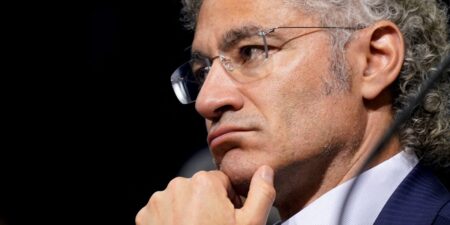X
Copy link
Impact Link
Save
Saved
Read in app
subscribers. Become an Insider
and start reading now.
Have an account? .
- Costco is buying more US-made items and rerouting inventory to avoid raising prices due to tariffs.
- I shopped at Costco in June and compared prices to when the tariffs were announced in April.
- A few items were more expensive, but most cost the same, and some had even gotten cheaper.
While some retailers are raising prices due to President Donald Trump’s sweeping “reciprocal” tariffs on over 180 countries, Costco is taking a different approach.
On Costco’s third-quarter earnings call on May 29, CEO Ron Vachris said the company is buying more items produced in the US and rerouting inventory bound for US stores to locations in other countries to avoid paying tariffs and raising prices.
“We’re watching pricing daily, and if not hourly, on every key commodity,” Vachris said.
This strategy was evident on my latest shopping trip.
When the tariffs were announced in April, I tracked the origins of every item I purchased at Costco to see how much of my usual grocery list could be affected. Out of the 23 items I bought in April, at least 12 were imported or contained imported ingredients.
I took the same grocery list to Costco in June and tracked all of the price changes I saw. While a few items from my April grocery list had gotten more expensive, most of the prices had stayed the same, and some had even decreased.
Some of the changes I tracked may be due to tariffs, but they could also be regular fluctuations caused by other factors such as inflation or supply and demand. A representative for Costco declined to comment.
While some of Trump’s tariffs took effect immediately in April, others have been paused until July. Even as some other stores have announced increased prices due to tariffs, the measures have yet to spike prices across the board. The Bureau of Labor Statistics found that the consumer price index, a measure of the average change in prices paid by urban consumers over time, increased by 0.1% in May, and the food index rose by 0.3%.
Here are all of the price differences I noticed at Costco.
As per usual, a long line stretched outside Manhattan’s sole Costco store when I arrived just before its 10 a.m. opening.
Beginning June 30, Costco’s executive members will be able to shop an hour earlier than Gold Star members. I hope this exclusive access will mean shorter lines and a less crowded shopping experience first thing in the morning.
I was surprised that most of the produce I bought cost the same as it did on my last grocery trip, even though much of it was imported.
Trump announced 25% tariffs on both Mexico and Canada in February, months before the “Liberation Day” establishment of “reciprocal” tariffs on other countries in April. Agricultural products were not subject to the new tariffs per the United States-Mexico-Canada Agreement, but the US will begin taxing Mexican tomatoes with a 21% duty beginning July 14, the Associated Press reported.
Despite being a product of Mexico with a Canadian distributor, a two-pound tomato medley from Sunset stayed the same price at $7.99.
Other products of Mexico and Canada on my shopping list, such as raspberries, cucumbers, and mashed avocado packets, also cost the same as they did in April.
I’d anticipated higher prices on produce at Costco as the CEOs of companies like Walmart and Target warned consumers of potential grocery price hikes due to tariffs.
The one exception was grapes, which were a product of the US and cost 50 cents more than the imported grapes I bought in April.
Last time I shopped at Costco in April, I bought 3 pounds of purple grapes from Chile for $7.49. On this visit in June, Costco stocked a different brand of red grapes grown in the US that cost $7.99 for a 3-pound package.
In the third-quarter earnings call, Vachris said the company planned to buy more domestically made products as alternatives to increasingly expensive imported items.
With a domestic supplier, the grapes still slightly increased in price, which could be due to different production and labor costs at the new supplier.
Kirkland’s organic roasted seaweed, sourced from South Korea, cost a dollar more than it did in April — a 9% price increase from $10.99 to $11.99.
Trump imposed a 25% tariff on South Korea.
The price of Kind bars, which are made in the US, had decreased by about 11.5% since my last trip.
The box of 22 bars said that they were made in the US “with domestic and imported ingredients.” The price of the Kind bars decreased from $19.99 in April to $17.69 in June.
The price of Costco’s Kirkland-brand lemonade went up 10 cents, from $6.29 in April to $6.39 in June for two 3-quart bottles.
Costco’s US branch distributes the lemonade, but the label doesn’t say where it was produced or where its ingredients were sourced.
If the lemons used are not grown in the US, it’s possible that they’ve become more expensive to import due to tariffs. India, Mexico, and China are the top three lemon producers in the world, The Takeout reported, and were all hit with steep tariffs: 26% on India, 25% on Mexico, and 10% on China.
Costco didn’t respond to a request for comment.
Other juices on my shopping list, such as gallon-sized bottles of passion orange guava juice, cost the same as they did in April at $5.99 each.
Some price changes were due to limited-time sales, like a $3 discount on Nature’s Path organic granola.
Nature’s Path organic granola was on sale for $5.99 during my June shopping trip. I’d previously paid $8.99 in April.
The pumpkin seed and flax granola comes in 35.5-ounce bags. Nature’s Path’s website says that it “does not currently purchase any products internationally that would require ‘product of…’ labeling.”
Egg prices at Costco decreased dramatically.
In February, I bought a carton of 24 cage-free large eggs at Costco for $8.49. I was lucky to even get one — the supply ran out just minutes after the store opened due to shortages caused by avian flu.
Things have improved steadily since then as the bird flu outbreak has become better contained. When I shopped at Costco in April, a carton of 24 cage-free large eggs cost $7.69. In June, the price lowered to $5.79, with an overall decrease of around 32% since February.
Overall, prices at Costco hadn’t changed much. Their strategy appears to be working.
Out of the 23 items on my grocery list I compared from April, only three became more expensive, and three decreased in price.
On the third-quarter earnings call, Costco CFO Gary Millerchip said that keeping prices low for members pays off despite squeezed profit margins. When prices eventually fall, he said, it allows the company to “feel the margin relief faster while also being able to lower prices more quickly than our competitors.”
I’m grateful Costco has largely kept its prices the same, choosing to lower profit margins instead of passing higher costs on to consumers.
Read the full article here
















